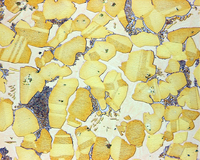
Photo from wikipedia
Abstract This paper presents a novel approach to model the effects of surface roughness on fatigue of tensile specimens. Voronoi tessellation was employed to simulate material microstructure and generate rough… Click to show full abstract
Abstract This paper presents a novel approach to model the effects of surface roughness on fatigue of tensile specimens. Voronoi tessellation was employed to simulate material microstructure and generate rough surfaces. Continuum damage mechanics was utilized to model progressive material degradation due to fatigue loading. In order to evaluate and corroborate the results from the finite element fatigue damage model, an experimental investigation was conducted on 4130 steel specimens under fully reversed loading. SEM Imaging was performed to obtain grain morphology parameters to model microstructure accurately using Voronoi grains. R a measured from optical surface profilometry was utilized to model roughness. Three levels of roughness were chosen for this study. Damage parameters for fatigue modeling were obtained from the experimental SN results of the smooth specimens having R a = 0.1 μm. The same parameters were used to model fatigue of numerically generated rough domains and predict a reduction in fatigue lives with increase in R a . The randomness originating from microstructure and surface profile predicts a scatter in fatigue lives. The fatigue failure mechanism predicted by the model is in close agreement with experimental observations. The reduction in endurance limit with increasing roughness level as predicted by the model provides better accuracy than the widely used empirical relationship for surface finish factor k a .
Journal Title: International Journal of Fatigue
Year Published: 2019
Link to full text (if available)
Share on Social Media: Sign Up to like & get
recommendations!